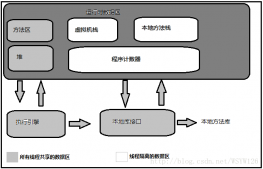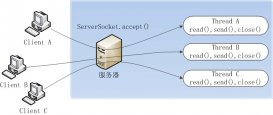前言
因为业务要求api的一次请求响应时间在10ms以内,所以传统的数据库查询操作直接被排除(网络io和磁盘io)。通过调研,最终使用了bieset,目前已经正常运行了很久
bitset介绍
看JDK中的解释简直一头雾水,用我自己的理解概括一下
1.bitset的内部实现是long数组
2.set中每一个位的默认值为false(0)
3.bitset长度按需增长
4.bitset非线程安全
bitset关键方法分析
|
1
2
3
4
5
6
7
8
9
10
11
12
13
14
15
16
17
18
|
/** * Sets the bit at the specified index to {@code true}. * * @param bitIndex a bit index * @throws IndexOutOfBoundsException if the specified index is negative * @since JDK1.0 */public void set(int bitIndex) { if (bitIndex < 0) throw new IndexOutOfBoundsException("bitIndex < 0: " + bitIndex); int wordIndex = wordIndex(bitIndex); expandTo(wordIndex); words[wordIndex] |= (1L << bitIndex); // Restores invariants checkInvariants();} |
设置指定“位”为true,bitIndex参数为非负整数。假设我们执行以下代码,观察上面代码中worIndex,words[wordIndex]值的变化
|
1
2
3
4
5
6
|
BitSet bs = new BitSet()bs.set(0);bs.set(1);bs.set(2);bs.set(3);bs.set(4); |
| bitIndex | wordIndex | words[wordIndex] | words[wordIndex]二进制表示 |
|---|---|---|---|
| 0 | 0 | 1 | 0001 |
| 1 | 0 | 3 | 0011 |
| 2 | 0 | 7 | 0111 |
| 3 | 0 | 15 | 1111 |
| 4 | 0 | 31 | 0001 1111 |
通过上表,我们可以很清晰的根据bitIndex和words[wordIndex]二进制值的对应关系,得到一个结论,即:bitset中每一个long可以表示64个非负整数在bitSet中存在与否。例如:0001可以表示整数0在bitset中存在,1111可以表示整数3,2,1,0在bitset中存在。
进入正题,实现bitset毫秒级查询
想象一个场景,我们有一张user表
|
1
2
3
4
5
6
7
8
|
CREATE TABLE `user` ( `id` int(11) NOT NULL AUTO_INCREMENT, `name` varchar(255) NOT NULL, `address` varchar(255) NOT NULL comment '地址', `gender` varchar(10) NOT NULL comment '性别', `age` varchar(10) NOT NULL, PRIMARY KEY (`uid`)) ENGINE=InnoDB AUTO_INCREMENT=0 DEFAULT CHARSET=utf8; |
假设我们要查询“北京市18岁的女生”,那么对应的sql如下:
|
1
|
select * from `user` where address='北京' and age='18' and gender='girl'; |
如何使用bitset实现同样的查询呢?
1.将user表数据加载进内存中
2.为user表建立address,age,gender维度的bitset索引
3.根据索引查询数据
1.将user表数据加载进内存中
将user表从数据库读取出来存入List
User实体类:
|
1
2
3
4
5
6
7
8
9
10
11
12
13
14
15
16
17
18
19
20
21
22
|
public class User implements Cloneable { private String name; private String address; private String gender; private String age; @Override public String toString() { return "User [name=" + name + ", address=" + address + ", gender=" + gender + ", age=" + age + "]"; } @Override public User clone() { User user = null; try { user = (User) super.clone(); } catch (CloneNotSupportedException e) { e.printStackTrace(); } return user; } //省略get set 方法。。。 |
2.建立索引
创建bitset索引模型类
|
1
2
3
4
5
6
7
8
9
10
11
12
13
14
15
16
17
18
19
20
21
22
23
24
25
26
27
28
29
30
31
32
33
34
35
36
37
38
39
40
41
42
43
44
45
46
47
48
49
50
51
52
53
54
55
56
57
58
59
60
61
62
63
64
65
66
67
68
69
70
71
72
73
74
75
76
77
78
79
80
81
82
83
84
85
86
87
88
89
90
91
92
93
94
95
96
97
98
99
100
101
102
103
104
105
106
107
108
109
110
111
112
113
114
115
116
117
118
119
120
121
122
123
124
125
126
127
128
129
130
131
132
133
134
135
136
137
138
139
140
141
142
143
144
145
146
147
148
149
150
151
152
153
154
155
156
157
158
159
160
|
public class BitSetIndexModel { private String type;//索引类型:address,age,gender private ConcurrentHashMap<String, Integer> map;//索引类型和bitSet在bsList中下标的映射关系 private List<String> list;//索引类型的值集合,例如gender:girl,boy private List<BitSet> bsList;//bitset集合 public BitSetIndex() { } public BitSetIndexModel(String type) { this.type = type; map = new ConcurrentHashMap<String, Integer>(); list = new ArrayList<String>(); bsList = new ArrayList<BitSet>(); } public String getType() { return type; } public void setType(String type) { this.type = type; } public Map<String, Integer> getMap() { return map; } public void setMap(ConcurrentHashMap<String, Integer> map) { this.map = map; } public List<String> getList() { return list; } public void setList(List<String> list) { this.list = list; } public List<BitSet> getBsList() { return bsList; } public void setBsList(List<BitSet> bsList) { this.bsList = bsList; } /** * * @param str * @param i */ public void createIndex(String str, int i) { BitSet bitset = null; //获取‘str'对应的bitset在bsList中的下标 Integer index = this.getMap().get(str); if (index != null) { bitset = this.getBsList().get(index); if (bitset == null) { bitset = new BitSet(); this.getBsList().add(index, bitset); } bitset.set(i, true);// 将str对应的位置为true,true可省略 } else { bitset = new BitSet(); List<String> list = this.getList(); list.add(str); index = list.size() - 1; bitset.set(i, true); this.getBsList().add(bitset); this.getMap().put(str, index); } } /** * 从entity里拿出符合条件的bitset * * @param str * @return */ public BitSet get(String str) { BitSet bitset = null; str = str.toLowerCase(); Integer index = this.getMap().get(str); if (index != null) { bitset = this.getBsList().get(index); } else { bitset = new BitSet(); } return bitset; } /** * bitset的与运算 * * @param str * @param bitset * @return */ public BitSet and(String str, BitSet bitset) { if (str != null) { str = str.toLowerCase(); if (bitset != null) { bitset.and(get(str)); } else { bitset = new BitSet(); bitset.or(get(str)); } } return bitset; } /** * bitset的或运算 * * @param str * @param bitset * @return */ public BitSet or(String str, BitSet bitset) { if (str != null) { str = str.toLowerCase(); if (bitset != null) { bitset.or(get(str)); } else { bitset = new BitSet(); bitset.or(get(str)); } } return bitset; } /** * 获取bitset值为true的 即 把 bitset翻译为list的索引 * * @param bitset * @return */ public static List<Integer> getRealIndexs(BitSet bitset) { List<Integer> indexs = new ArrayList<Integer>(); if (bitset != null) { int i = bitset.nextSetBit(0); if (i != -1) { indexs.add(i); for (i = bitset.nextSetBit(i + 1); i >= 0; i = bitset.nextSetBit(i + 1)) { int endOfRun = bitset.nextClearBit(i); do { indexs.add(i); } while (++i < endOfRun); } } } return indexs; } } |
为每一个user对象创建address,gender,age维度索引
|
1
2
3
4
5
6
7
8
9
10
11
12
13
14
15
16
17
18
19
20
21
22
23
24
25
26
27
28
29
30
31
32
33
34
35
36
37
38
39
40
41
42
43
44
45
46
47
48
49
50
51
52
53
54
55
56
57
58
59
60
61
62
63
64
65
66
67
68
69
70
71
72
73
74
75
76
77
78
79
80
81
82
83
84
85
86
87
88
|
public class UserIndexStore { private static final String ADDRESS = "address"; private static final String GENDER = "gender"; private static final String AGE = "age"; private BitSetIndexModel address; private BitSetIndexModel gender; private BitSetIndexModel age; private ConcurrentHashMap<Integer, User> userMap;//存储所有的user数据 public static final UserIndexStore INSTANCE = getInstance(); private UserIndexStore() { init(); } public static UserIndexStore getInstance() { return UserIndexStoreHolder.instance; } private static class UserIndexStoreHolder { private static UserIndexStore instance = new UserIndexStore(); } private void init() { this.address = new BitSetIndexModel(ADDRESS); this.gender = new BitSetIndexModel(GENDER); this.age = new BitSetIndexModel(AGE); userMap = new ConcurrentHashMap<Integer, User>(); } /** * 构建索引 * @param users */ public void createIndex(List<User> users) { if (users != null && users.size() > 0) { for (int index = 0; index < users.size(); index++) { User user = users.get(index); getAddress().update(user.getAddress(), index); getGender().update(user.getGender(), index); getAge().update(user.getAge(), index); this.userMap.put(index, user); } } } public BitSet query(String address, String gender, String age) { BitSet bitset = null; bitset = getAddress().and(address, bitset); bitset = getGender().and(gender, bitset); bitset = getAge().and(age, bitset); return bitset; } public User findUser(Integer index) { User user = this.userMap.get(index); if (user != null) { return user.clone();//可能会对user做修改操作,要保证内存原始数据不变 } return null; } public BitSetIndexModel getAddress() { return address; } public void setAddress(BitSetIndexModel address) { this.address = address; } public BitSetIndexModel getGender() { return gender; } public void setGender(BitSetIndexModel gender) { this.gender = gender; } public BitSetIndexModel getAge() { return age; } public void setAge(BitSetIndexModel age) { this.age = age; }} |
3.测试bitset
|
1
2
3
4
5
6
7
8
9
10
11
12
13
14
15
16
17
18
19
20
21
22
23
24
25
26
27
28
29
30
31
32
33
34
35
36
37
38
39
40
41
42
43
44
45
46
47
48
49
50
|
public class BitSetTest { public static void main(String[] args) { List<User> users = buildData(); UserIndexStore.getInstance().createIndex(users); ExecutorService executorService = Executors.newFixedThreadPool(20); int num = 2000; long begin1 = System.currentTimeMillis(); for (int i = 0; i < num; i++) { Runnable syncRunnable = new Runnable() { @Override public void run() { List<Integer> indexs = BitSetIndexModel.getRealIndexs(UserIndexStore.getInstance().query("北京", "girl", "18")); for (Integer index : indexs) { UserIndexStore.getInstance().findUser(index); } } }; executorService.execute(syncRunnable); } executorService.shutdown(); while (true) { try { if (executorService.awaitTermination(1, TimeUnit.SECONDS)) { System.out.println("单次查询时间为:" + (System.currentTimeMillis() - begin1) / num + "ms"); break; } } catch (InterruptedException e) { e.printStackTrace(); } } } private static List<User> buildData() { String[] addresss = { "北京", "上海", "深圳" }; String[] ages = { "16", "17", "18" }; List<User> users = new ArrayList<>(); for (int i = 0; i < 200000; i++) { User user = new User(); user.setName("name" + i); int rand = ThreadLocalRandom.current().nextInt(3); user.setAddress(addresss[ThreadLocalRandom.current().nextInt(3)]); user.setGender((rand & 1) == 0 ? "girl" : "boy"); user.setAge(ages[ThreadLocalRandom.current().nextInt(3)]); users.add(user); } return users; }} |
测试结果(查询2w次):
数据量(users.size()) | 并发数 | 平均查询时间
---|---|---
20w | 10 | 1ms
50w | 20 | 3ms
100w| 50 | 9ms
测试机为thinkpad x240 i5 8g内存
4.总结
==优点==:
通过测试发现随着数据量的增大和并发数的提高,平均耗时并没有明显升高,并且响应时间都在10ms以内
==缺点==:
1.不适合数据量太大的情况,因为需要把数据全部加载进内存
2.不适合复杂查询
3.不适合对name,id等唯一值做查询
后记
因为我们的查询业务比较简单,唯一的要求是速度,并且数据量也不大,每张表的数据量都不超过100w,所以使用这种方式比较合适。
在本篇文章中只谈到了如何创建索引,以及最基本的查询,在下一篇中我会继续说明如何更新索引,以及一些复杂查询,比如<,>,between and。
以上这篇使用bitset实现毫秒级查询(实例讲解)就是小编分享给大家的全部内容了,希望能给大家一个参考,也希望大家多多支持服务器之家。
原文链接:http://www.cnblogs.com/ncbest/archive/2017/10/23/7703615.html














